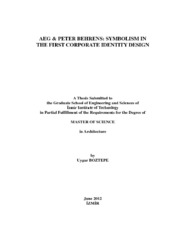Please use this identifier to cite or link to this item:
https://hdl.handle.net/11147/3505Full metadata record
| DC Field | Value | Language |
|---|---|---|
| dc.contributor.advisor | Yücel, Şebnem | en |
| dc.contributor.author | Boztepe, Uygar | - |
| dc.date.accessioned | 2014-07-22T13:51:42Z | - |
| dc.date.available | 2014-07-22T13:51:42Z | - |
| dc.date.issued | 2012 | en |
| dc.identifier.uri | http://hdl.handle.net/11147/3505 | - |
| dc.description | Thesis (Master)--İzmir Institute of Technology, Architecture, İzmir, 2012 | en |
| dc.description | Text in English; Abstract: Turkish and English | en |
| dc.description | xi, 116 leaves | en |
| dc.description.abstract | Some historians called Peter Behrens' designs for AEG as first corporate identity design without a detailed analysis. Another group of the historians claimed that his works for AEG were shaped by only function or machine-aesthetic. Even some of these historians saw Behrens' works as inceptors of functionalism or rationalism in modern architecture. This thesis attempts to fill the gap in literature by analyzing Behrens' works for AEG in order to understand whether his designs formed a corporate identity or not. In order to show the shortcomings of such readings, the thesis explores the symbols that were used in the designs of Behrens, even in his most-functionalist design-works. The discussion was carried out through analysis of Behrens’ and his contemporaries’ written and design works, with materials available in Klingspor, Mathildenhöhe and TechnikMuseum Berlin Archives. This analysis is done through a review of scientific management techniques and their reflections in architectural culture and by parallel readings of literature and architecture in Germany at the turn of the century. As the discussion of the thesis pointed out, Peter Behrens' designs for AEG can be called as first corporate identity design since they have a consistent design vocabulary. While designing for AEG Behrens used scientific management and mass-production techniques in his designs. However these were not the only forces that shaped his design-work. One can see the vestiges of the symbols in his works that are coming from literature and antiquity. The thesis argues that it is not possible to fully understand the architecture of Behrens without understanding symbols. The thesis hopes to make a new reading of modern architecture from a different point of view, which includes a discussion on symbolism in modern architecture, avoiding oversimplification and reductionism present in readings with functionalist focus. | en |
| dc.language.iso | en | en_US |
| dc.publisher | Izmir Institute of Technology | en_US |
| dc.rights | info:eu-repo/semantics/openAccess | en_US |
| dc.subject.lcsh | Behrens, Peter, 1868-1940--Criticism and interpretation | en |
| dc.subject.lcsh | AEG-Telefunken | en |
| dc.subject.lcsh | Corporate image | en |
| dc.subject.lcsh | Industrial design | en |
| dc.subject.lcsh | Architectural design | en |
| dc.title | AEG and Peter Behrens: Symbolism in the first corporate identity design | en_US |
| dc.type | Master Thesis | en_US |
| dc.institutionauthor | Boztepe, Uygar | - |
| dc.department | Thesis (Master)--İzmir Institute of Technology, Architecture | en_US |
| dc.relation.publicationcategory | Tez | en_US |
| item.fulltext | With Fulltext | - |
| item.grantfulltext | open | - |
| item.languageiso639-1 | en | - |
| item.openairecristype | http://purl.org/coar/resource_type/c_18cf | - |
| item.cerifentitytype | Publications | - |
| item.openairetype | Master Thesis | - |
| Appears in Collections: | Master Degree / Yüksek Lisans Tezleri | |
Files in This Item:
| File | Description | Size | Format | |
|---|---|---|---|---|
| T001049.pdf | MasterThesis | 6.97 MB | Adobe PDF |  View/Open |
CORE Recommender
Page view(s)
362
checked on Nov 18, 2024
Download(s)
4,602
checked on Nov 18, 2024
Google ScholarTM
Check
Items in GCRIS Repository are protected by copyright, with all rights reserved, unless otherwise indicated.